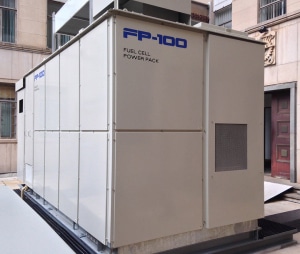South Africa is the biggest economy on the African continent, and since the end of apartheid more than 20 years ago, the country has been viewed as a role model by many of its neighbors. Because of its very healthy economic development, the nation at the Cape of Good Hope has become part of the BRICS group of countries. There is, however, the issue of unstable energy supply as well as the uneven spread of wealth among the population, which has meanwhile begun to hamper South Africa’s progress and is posing great challenges to the government. The use of hydrogen and fuel-cell technology is thus not only viewed as an opportunity for economic growth, but also – and most importantly – as a chance to right the wrongs in energy policy.
There are two main drivers behind the use of H2 and fuel-cell technology in South Africa today: One is mining, South Africa’s most important industry sector. Besides chrome, vanadium and manganese, the country is rich in platinum (more precisely, platinum group metals or PGMs). Its use in fuel cells offers new opportunities for incorporating another process into the platinum value chain and establish a new industry.
The second one is the big problem of secure power supply. South Africa’s power grid is outdated and ailing. Power outages and shutdowns are the rule rather than the exception, which is placing a burden on businesses as well. Additionally, the grid does by no means cover the entire country. Up to 600,000 households, especially in underdeveloped rural areas, still have no access to it. For many South-Africans, growth and wealth remain out of reach, which fuels widespread dissatisfaction.
As early as 2008 did the South-African government establish the Hydrogen South Africa (HySA) program, which is to run over 15 years as part of a research, development and innovation strategy. Originally thought up to strengthen the platinum industry, the program is now seen by the government as an opportunity to improve energy supply primarily in telecommunications as well as network-independent electricity generation through the use of hydrogen and fuel-cell technology. Moreover, the technology is viewed as helping to meet the CO2 targets stipulated in the National Development Plan as well as to support the climate policies of the government.
Whereas in early years, the focus of the program used to be gathering and expanding the knowledge about the technology, the past three have seen the realization of different demonstration projects, which were intended to showcase the technology’s benefits to the public:
In 2014, Anglo American Platinum, one of the biggest mining companies in South Africa, had fuel-cell systems set up as part of a pilot project at the rural Naledi Trust community near Kroonstad. In a first step, 34 households were connected to a small, independent power grid. If the initial stage proves successful, the network is planned to be expanded to include a total of 200 to 300 households.
Since the end of last year, the University of the Western Cape has been testing a fuel-cell unit at its nature reservoir in Cape Town. The unit is intended to supply power for the lighting of the administration building. Since the beginning of this year, the electricity for the building of the Chamber of Mines in Johannesburg has been generated by a 100-kW fuel-cell system. The phosphoric acidic fuel cell (PAFC, see photo) by Fuji Electronics is powered by natural gas and covers the building’s basic load.
A 5-kW emergency power supply system by Intelligent Energy was recently set up in Bhisho, the capital of the Eastern Cape province. It cools vaccine supplies, which had to be regularly disposed of before because of power outages. There are also plans to equip up to 20 agricultural parks in remote rural areas in South Africa with fuel-cell systems over the next two to three years. Three schools in Cofimvaba in the Eastern Cape province were chosen to serve as pilot projects. There, charging stations for PCs and faxes are said to run based on fuel-cell energy.
The South-African mining companies see hydrogen and fuel-cell applications as more than an opportunity to generate increased demand for platinum. They also want to use these technologies to enhance their own production processes and refineries. Five fuel-cell trains powered by natural gas have already been running through the mine shafts of Anglo American Platinum. A cost comparison between trains running on diesel and the ones driven by fuel cells concluded that the costs for diesel use were between 4 and 6 rand (0.3 to 0.45 euro) per kilowatt hour, whereas – depending on the natural gas price – fuel-cell costs ranged from 2.7 to 3 rand per kilowatt hour (0.2 to 0.3 euro).
Platinum giant Impala announced that it would install a power supply based on fuel cells at its refinery in Springs, Gauteng province. The system is planned to be supplied by the excess hydrogen from the refinery‘s metal reduction process and would thus contribute to plant operations becoming independent of the national power grid.
The government recently carried out an evaluation of the HySA program after half-time: There is still too little awareness of hydrogen and fuel cells and their potential throughout the country. Now, the government wants to advance the issue on all fronts and continue offering financial support for relevant projects. This is all the more important when it comes to establishing a hydrogen infrastructure. The government identified the electrification of rural areas, the use in mining and the employment in telecommunications as the top-priority H2 and fuel-cell markets in South Africa. There is also a call for greater involvement of small to medium enterprises. Additionally, the government is deliberating the establishment of special economic zones to develop hydrogen and fuel-cell technology. These zones would be designed with low taxes in mind, in order to accelerate market deployment.
Author: Alexandra Huss


























0 Comments